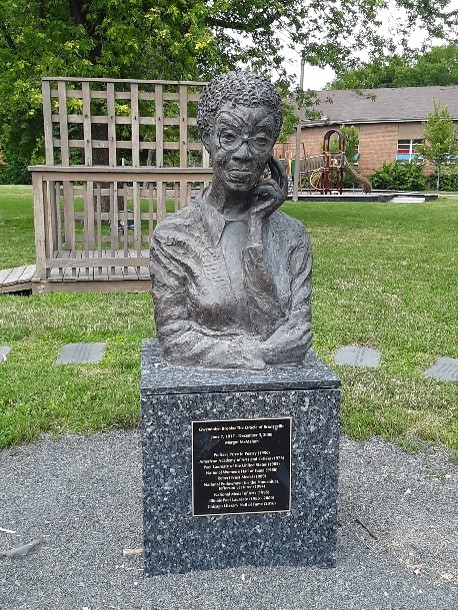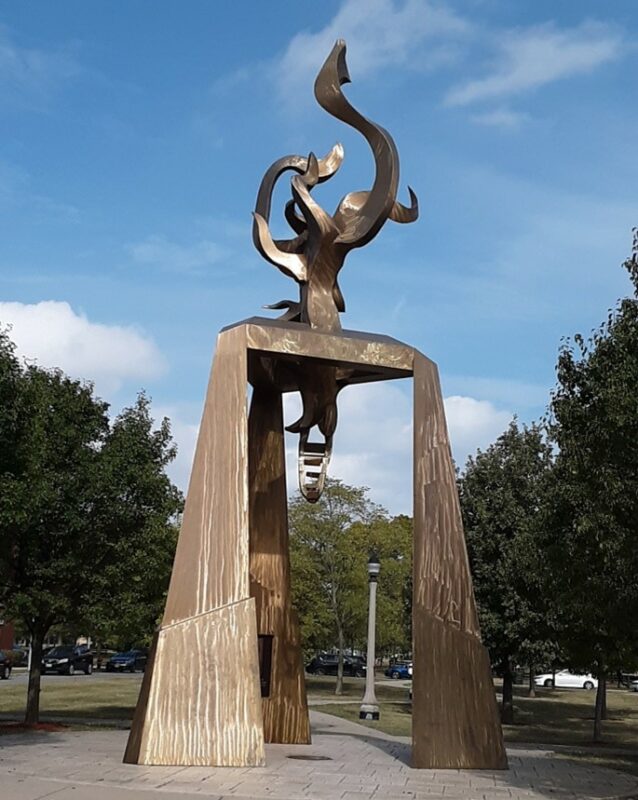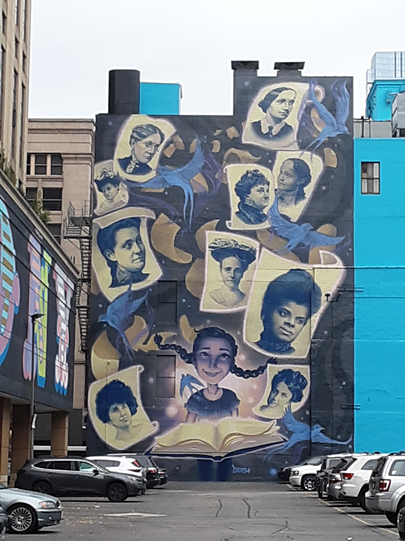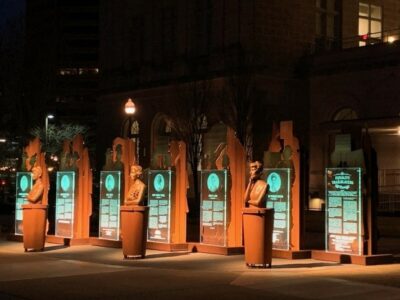So few images of African American women, so much resistance to adding more
01 February 2022 – Michelle Duster
suffrage, art, women's history, community history, public art, memory, sense of place, race, monuments
A few years ago, Curious City ran an article highlighting the dearth of representation of women in public statuary in Chicago and asked for suggestions on who should be honored. Several dozen were named, with several of them being women of color. Although many people knew intuitively that Black women are woefully underrepresented in numerous areas of American society, including public artwork, the numbers from studies and surveys chronicle the disparity. Thirty percent of Chicago’s population is African American, yet out of fifty outdoor statues, only one bust is the image of a Black woman—Gwendolyn Brooks—and one monument in tribute to Ida B. Wells includes her image. Both projects were installed within the last four years. Nationally, fewer than seven percent of public artwork features women, with a fraction being of African American women.

“Gwendolyn Brooks: The Oracle of Bronzeville” (2018) by Margot McMahon in Gwendolyn Brooks Park on the South Side of Chicago. Photo credit: Michelle Duster
As exciting as these projects are, they barely put a dent into the disparity. More needs to be done. A skewed and incomplete view of who built and shaped this country has been perpetuated in public artwork with disproportionate representation of white men, and the extreme underrepresentation of women and minorities. Monuments to white male war leaders contribute to a false narrative about the U.S. and its history that has been perpetuated for generations by a culture of white supremacy. The Chicago Monuments Project was recently created to examine how our history is told in public spaces.

“Light of Truth: Ida B. Wells National Monument” (2021) by Richard Hunt. Located at 37th & Langley in Chicago’s Bronzeville neighborhood. Photo credit Michelle Duster
In order to address this lack of representation and to celebrate the centennial of the 19th Amendment, a group of six women formed the Chicago Womxn’s Suffrage Tribute Committee (CWSTC) and worked in conjunction with the Wabash Arts Corridor to secure two walls in a prominent location in downtown Chicago to celebrate local suffragists and the political triumphs of women over the past century. The committee was purposeful about being as inclusive as possible while highlighting ten women in their commissioned mural. Lori Osborne, a member of CWSTC explained, “Multi-racial representation in the mural was crucial in order to capture the unique history of Illinois that not only made partial suffrage available in 1913, seven years before the 19th Amendment was passed but also boasted coalitions of women across race in order to make that happen.”
On the Wings of Change by Diosa (Jasmina Cazacu) was installed in October 2021 and includes portraits of seven white women—Jane Addams, Myra Bradwell, Mary Livermore, Catherine Waugh McColloch, Agnes Nestor, Grace Wilbur Trout, and Frances Willard—and three Black women: Mary Fitzbutler Waring, Ida B. Wells, and Fannie Barrier Williams. Several of those suggested in Curious City’s survey are now represented on the mural. The large-scale 7-story piece is 45 feet long and 80 feet high and is the largest outdoor tribute to suffragists in the city of Chicago.

“On the Wings of Change” (2021) by Diosa (Jasmina Cazacu). Located on the south wall of 33 E. Ida B. Wells Drive in downtown Chicago. Photo credit: Michelle Duster
The original vision for the mural project was to have the portrait mural be accompanied by another large-scale (240 feet long and 30 feet high), horizontal, text-based piece by Dorian Sylvain titled Speak Up with the wording “I’m Speaking” attributed to Vice President Kamala Harris. Situated in a highly trafficked touristy area near several universities, the completed two-mural project would have visually tied the legacy of those who fought for the right to vote to the election of a woman to the vice presidency exactly one hundred years after the 19th Amendment was passed.
Unfortunately, the vision will need to be altered because a white male owner of the parking lot adjacent to the building refused to rent spaces that were needed for installation equipment. He claimed Speak Up was too political and would hurt his business. By blocking the project, he in fact continued the long history of marginalizing and erasing Black women.
The Committee was stunned by his action and interpreted it as a combination of misogyny and racism. Two members of the committee wrote articles to inform the public about the racial and gender dynamics exhibited in his response: one in Ms. Magazine to highlight how a white man blocking a Black woman artist as well as artwork celebrating a Black woman’s political achievement fits a long history of violence perpetrated against Black women, and another in New City Art to explain the specific challenges that female artists face in creating public art. The Committee also sought additional media coverage of the situation in order to gain public support for the project. The Chicago Sun-Times published an article and an episode for City Cast podcast was released, but these efforts did not influence the parking lot owner to change his stance.
The Committee is considering all of their options to have the work installed without getting into a legal battle or public relations struggle. The goal is to stay true to the vision of having the two murals in close proximity to connect the past to the present. Between the property owners, artists, funders, Committee, and the artist, a determination will be made about how to complete the mural within the next few months.
Luckily, several other projects around the country that feature real women (versus mythical or fictional female characters) have been initiated or completed within the last few years. These include She Built NYC, that aims to honor seven women through monuments in each borough of New York City; the 2019 installation of the Virginia Women’s Monument in Richmond, which has statues of twelve women plus hundreds of names on a wall; the statue of Elizabeth Cady Stanton, Susan B. Anthony, and Sojourner Truth in New York’s Central Park that was installed in 2020; and most recently, the Equality Trailblazers monument in Memphis, that features twelve women (five of whom are Black) and one male leader, was installed in December 2021. As Paula F. Casey, chair of the Memphis Suffrage Monument Committee explained, “There is a dearth of statuary featuring women, particularly Black women, who were historically significant in the pursuit of equality and deserve recognition.”

Memphis Suffrage Monument “Equality Trailblazers” (Alan LeQuire). Located at the University of Memphis facing the Mississippi River. Busts (L-R) are Ida B. Wells, Mary Church Terrell, and Marion Griffin. Installed, December 2021. Photo credit: Andrée LeQuire
Real women are slowly dotting the landscape across the country. Having more and more equitable representation of real women will serve to tell the story of the United States in a more truthful and complete way. Women have been part of this country for its entire existence and made meaningful contributions. The public narrative of the country needs to reflect that.
Michelle Duster is an educator and activist whose advocacy has led to street names, monuments, historical markers, and other public history projects. She is a member of CWSTC and the author of several books, including Ida B. the Queen: The Extraordinary Life and Legacy of Ida B. Wells (2021) and Ida B. Wells, Voice of Truth (2022) which are about her paternal great-grandmother.




“Curious City ran an article highlighting the dearth of representation of women in public statuary in Chicago”– what first came to mind was, “how about the dearth of representation of women in public statuary across America?!?”
Author and historian, Michelle Duster is so on-point.
As long and as hard as she has worked thus far, it is going to take way more than her voice to raise public awareness via diverse and deliberate media attention to change the narrative of how generations will view women’s, particularly the overlooked African American women’s participation and contributions in the formation of this country.
It also dares to threaten the myth that without White males, this country never would have progressed.
Until mere imagery of African Americans does not upset White people, Michelle Duster and other historians like her, need broader platforms to communicate truth and deliver physical representation along with constant reminders to us of America’s true history until it is no longer trending “news” and simply public knowledge to all.
I wonder how many generations that will take?
You’re right Cheryl. It will take a national collective effort to put a dent into addressing the disparity there is between white men’s representation and that of all women (and especially women of color). In this environment with even more efforts to erase us and our stories from the public sphere (banning books) the opponents to including our contributions are strong and growing. it’s very sad that our country is so resistent to inclusion and acknowledgment of all. But we must refuse to be erased and continue to press on.
Hi Cheryl,
As a photographer, and photojournalist I do a presentation called “Retrospective: Spirit of a People”. If you send your email address, I’m happy to send you a proposal.
Best,
Collette Fournier
[email protected]
845-304-5465